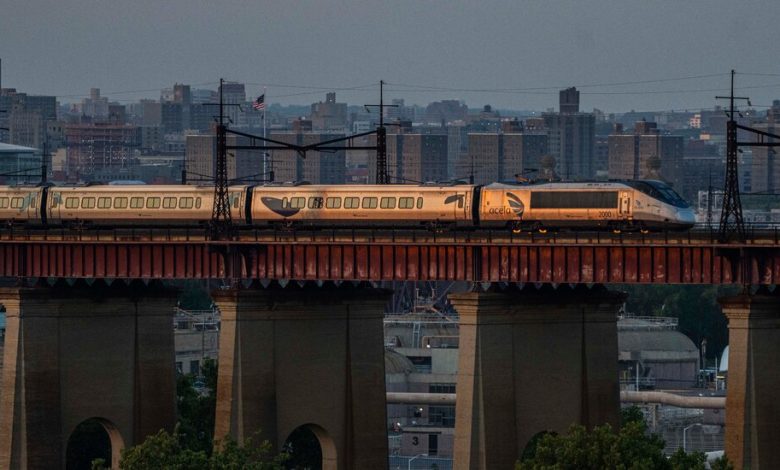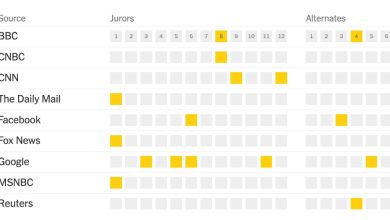After Years of Delays, Amtrak Moves Toward Faster Trains in the Northeast

After years of delays and safety and design disputes, Amtrak is one step closer to bringing new high-speed trains to the busy Northeast Corridor.
Amtrak officials said late Friday that the new trains, which had failed an extended series of computer modeling tests, had passed on the 14th try and had been cleared by the Federal Railroad Administration to begin testing on the tracks that run from Washington, D.C., to Boston.
The faster, more spacious trains — sets of locomotives plus passenger cars — come with a price tag of about $1.6 billion and are to replace those in the Acela fleet, which should have been decommissioned at the end of their life cycle in 2016.
The sleek new red, white and blue Avelia Liberty trains are to travel at a maximum speed of about 160 miles per hour because of a limit imposed by the Northeast Corridor’s aging tracks, 10 miles faster than the current Acela trains, and are expected to tilt for a faster and smoother ride around curves. They accommodate up to 386 passengers, an increase of 25 percent.
The testing on the tracks will be “the next step in the safety certification process that leads toward launching revenue service,” Amtrak said in a statement.
Cliff Cole, a spokesman for Alstom, the French manufacturer of the new trains, hailed the move to on-track testing as progress for passengers “who will soon discover a brand-new travel experience on the busiest rail corridor in America.”
But the project, three years behind schedule, has been plagued by major setbacks, and Amtrak has not said when the trains will be ready for passengers. Last fall, the passenger rail service was targeting October 2024 for the new trains to be put into service, according to an inspector general report. Alstom, which is building the trains in Hornell, N.Y., has delivered only 10 out of 28 that were contracted to be ready in 2021. For now, those 10 sit idle in a Pennsylvania trainyard, visible to Amtrak passengers going in and out of Philadelphia’s 30th Street Station.
In the meantime, Amtrak has spent more than $48 million on maintenance to keep the outdated Acela trains running.
There were big hopes back in 2016, when then-Vice President Joseph R. Biden Jr. and Anthony R. Coscia, Amtrak’s chairman at the time, stood outside a Wilmington, Del., train station and announced a $2.45 billion federal loan for Amtrak to bring high-speed train travel to the Northeast. That year, Amtrak selected Alstom, which had built the original Acela fleet in 2000, to manufacture the new trains.
Under the terms of the contract, Alstom was required to create a computer model to predict the performance of the trains before even starting to build them — a crucial stipulation, since the Federal Railroad Administration, which enforces rail safety regulations, must approve a model that demonstrates a train is safe before it can be tested on the Northeast Corridor tracks.
The corridor’s curves, bridges and tunnels presented a particular challenge for Alstom. The region’s tracks are estimated to need more than $100 billion in repairs and upgrades for the new trains to reach maximum speeds through the entire corridor.
By 2019, the company had run into trouble. According to Amtrak officials and Alstom representatives, the train manufacturer told Amtrak that computer modeling showed the new trains could not run safely on the Northeast Corridor tracks. Nonetheless, Alstom said the company could work out the problems and wanted to move ahead.
Amtrak gave Alstom the go-ahead to build the trains despite the computer modeling problems because, Amtrak officials said, they felt they had no other choice. More recently, Amtrak officials acknowledged that they failed to put safeguards into the contract with Alstom to protect themselves in the event the company struggled to develop working trains.
“I think there’s some debate now after the fact whether or not that should be a contractual mechanism,” said Laura Mason, Amtrak’s executive vice president for capital delivery.
By January 2020, an Amtrak inspector general’s report warned of continuing delays and safety problems with the trains, as did another inspector general’s report in September 2023. In an unredacted version of that more recent report obtained by The New York Times, inspectors found that the trains were still failing the modeling tests and that those that had been built so far had defects. Although the defects could be fixed, the report said, some trains required “structural and design modifications” while others needed “sealant, drainage or corrosion corrections.”
Jim Mathews, chief executive of the Rail Passenger Association, an advocacy group, said that as both Amtrak and Alstom move forward with testing the trains on the tracks, they will be paying close attention to tilting technology and how well it helps the trains make curves at high speeds.
“I would expect a pretty smooth testing regime from here on out because most of the problems have been identified,” Mr. Mathews said. “We will see how they run now that they will be on the Northeast Corridor.”




